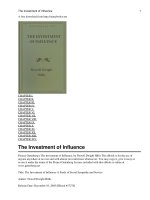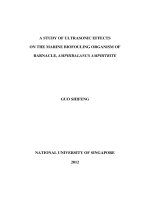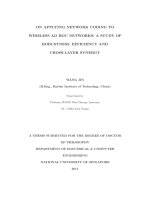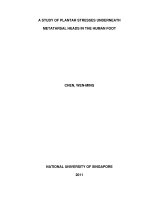A study of ultrasonic effects on the marine biofouling organism of barnacle, amphibalanus amphitrite
Bạn đang xem bản rút gọn của tài liệu. Xem và tải ngay bản đầy đủ của tài liệu tại đây (4.88 MB, 162 trang )
A STUDY OF ULTRASONIC EFFECTS
ON THE MARINE BIOFOULING ORGANISM OF
BARNACLE, AMPHIBALANUS AMPHITRITE
GUO SHIFENG
NATIONAL UNIVERSITY OF SINGAPORE
2012
A STUDY OF ULTRASONIC EFFECTS
ON THE MARINE BIOFOULING ORGANISM OF
BARNACLE, AMPHIBALANUS AMPHITRITE
GUO SHIFENG
(B. ENG. CQUT, M. ENG. CQU)
A THESIS SUBMITTED FOR
THE DEGREE OF DOCTOR OF PHILOSOPHY
DEPARTMENT OF MECHANICAL ENGINEERING
NATIONAL UNIVERSITY OF SINGAPORE
2012
Declaration
I
Declaration
I hereby declare that this thesis is my original work and it has been written by me in
its entirety. I have duly acknowledged all the sources of information which have been
used in the thesis. This thesis has also not been submitted for any degree in any
university previously.
Guo Shifeng
21 November 2012
Acknowledgements
II
Acknowledgements
First of all, I would like to express my sincere gratitude to my supervisors, Associate
Prof. Lee Heow Pueh and Prof. Khoo Boo Cheong, for providing me the precious
opportunity to study under their supervision. In the past four years, I indeed have
learnt and benefitted from their profound knowledge and strict academic attitude,
which will benefit my whole life. It is impossible for me to finish my thesis without
their invaluable guidance, sincere support, and continuous encouragement. Special
thanks to Associate Prof. Lim Siak Piang and Lim Kian Meng for their help and
suggestions in my research.
I would also like to express my appreciation to Dr. Serena Lay Ming Teo for her
sincere guidance and invaluable suggestions on my project. I would like to thank her
for providing me all the convenience and facilities for the barnacle experiments.
I gratefully acknowledge the financial support from National University of Singapore
through the Research Scholarship, without which it would have not been possible for
me to pursue my degree in NUS.
I would like to thank Ms. Serina Siew Chen Lee from TMSI (Tropical Marine
Science Institute) on the barnacle cyprids culture. I would also express my sincere
thanks to my fellow lab mates and friends Zhuang Han, Liu Yang, Tse Kwong Ming,
Acknowledgements
III
Zhu Jianhua, Chen Xiaobin, Thein Min Htike, Arpan Gupta, Wu Liqun, Liu Yilin,
and Sun Qiang for their help in the past four years.
I would like to thank the lab officers of dynamic lab for providing me the
convenience and help for my experiments.
Finally, I would express my deepest gratitude and love to my families for their
continuous support and sincere encouragement.
Table of contents
IV
Table of Contents
Declaration………………………………………………………………….……… I
Acknowledgements II
Summary………… VIII
List of Tables. X
List of Figures XI
Nomenclature XVI
Acronyms……… XVII
Chapter 1. Introduction 1
1.1. Marine biofouling 1
1.2. Development of fouling 2
1.3. Marine fouling organisms 4
1.3.1. Bacteria 4
1.3.2. Diatom 5
1.3.3. Green alga 5
1.3.4. Mussel 6
1.3.5. Barnacle 6
1.4. Strategies of fouling control 10
1.4.1. Biocides based methods 11
1.4.2. Non-toxic coatings 13
1.4.3. Physical methods 17
1.5. Effect of ultrasound on biofouling 18
1.5.1. Ultrasound applications on biofouling prevention 19
1.5.2. The application of ultrasound on barnacle prevention 20
1.6. Scope and objective of study 20
1.7. Thesis organization 21
Table of contents
V
Chapter 2. Effect of ultrasound on cyprids and juvenile barnacles 23
2.1. Introduction 24
2.2. Materials and methods 26
2.2.1. Ultrasonic irradiation system 26
2.2.2. Cyprid settlement and mortality assay 27
2.2.3. Cyprid exploration behavior assay 28
2.2.4. Barnacle growth assay 29
2.2.5. Statistical analysis 30
2.3. Results 30
2.3.1. Cyprid settlement assay 30
2.3.2. Cyprid mortality 32
2.3.3. Cyprid exploration behavioral assay 33
2.3.4. Barnacle growth assay 35
2.4. Discussion 36
2.5. Conclusion for chapter 2 40
Chapter 3. The exploration of the mechanism of ultrasound on barnacle
cyprid settlement inhibition 41
3.1. Introduction 42
3.2. Material and methods 43
3.2.1. Ultrasonic irradiation system 43
3.2.2. Cyprid settlement and mortality assay 44
3.2.3. Cyprid inhibition mechanism investigation 44
3.2.4. Ultrasonic emission spectrum analysis and cavitation energy estimation 45
3.2.5. Data analysis 47
3.3. Results 48
3.3.1. Cyprid settlement assay ………………………………………… 48
3.3.2. Settlement and mortality comparison between FSW and PDFSW 50
Table of contents
VI
3.3.3. Ultrasonic spectrum and cavitation energy analysis 52
3.4. Discussion and conclusion for chapter 3 54
Chapter 4. Investigation of low intensity ultrasound on barnacle cyprid
settlement…… 59
4.1. Introduction 60
4.2. Material and methods 61
4.2.1. Ultrasound irradiation setup 61
4.2.2. The choice of ultrasound amplitude 62
4.2.3. Cyprid settlement and mortality assay 64
4.2.4. Effect of low intensity, continuous ultrasound on cyprid behavior 65
4.2.5. Substratum vibration and acoustic pressure analysis 66
4.2.6. Intermittent ultrasonic irradiation 67
4.2.7. Efficient frequency band on cyprid settlement 69
4.2.8. Statistical analysis 69
4.3. Results 70
4.3.1. Acoustic pressure distribution measurement 70
4.3.2. Effect of continuous irradiation on cyprid settlement and mortality 71
4.3.3. Observations of cyprid exploration 73
4.3.4. Substratum vibration and acoustic pressure on settlement inhibition 74
4.3.5. Cyprid settlement under different cyclical irradiation modes 76
4.3.6. Efficient frequency band on cyprid settlement 77
4.4. Discussion 78
4.5. Conclusion for chapter 4 81
Chapter 5. Effect of ultrasound on cyprid footprints and juvenile barnacle
adhesion strength on a fouling release material 82
5.1. Introduction 83
5.2. Materials and methods 85
5.2.1. Surface preparation 85
Table of contents
VII
5.2.2. Ultrasound experimental setup 86
5.2.3. Cyprid settlement assay and juvenile barnacle culture 86
5.2.4. Footprint observation using AFM 87
5.2.5. Barnacle adhesion strength measurement 88
5.2.6. Data analysis 90
5.3. Results 91
5.3.1. Cyprid settlement 91
5.3.2. Images of FPs on NH
2
terminated surfaces 91
5.3.3. Adhesion strength comparison 93
5.4. Discussion 96
5.5. Conclusion for chapter 5 100
Chapter 6. The effect of cavitation bubbles on the removal of juvenile
barnacles…… 101
6.1. Introduction 102
6.2. Materials and methods 103
6.2.1. Barnacle culture 103
6.2.2. Ultrasonic experimental setup 104
6.2.3. Experimental setup for the spark generated bubbles 105
6.3. Results 107
6.3.1. Results of ultrasonic cavitation 107
6.3.2. Results of spark generated bubbles 110
6.4. Discussion 121
6.5. Conclusion for chapter 6 124
Chapter 7. Conclusions 125
Bibliography……………………………………………………………………….130
Publications… …143
Summary
VIII
Summary
Marine biofouling is the undesirable accumulation of microorganisms, plants, and
animals on man-made structures immersed in the sea. It generates serious impact on
the marine industries, in particular in the shipping industries where fouling increases
significant friction resistance and corrosion issues. It is estimated that billions of
dollars per year for excess oil consumption and maintenance costs. The impact of
biofouling also generates environmental issues such as an increase of green house gas
emission due to higher fuel consumption, production of large quantities of organic
waste during the cleaning and repainting process, and introduction of organisms into
new environments. Among the marine fouling organisms, barnacles are a major
problem due to their sizes and gregarious nature. In this thesis, a systematic study of
ultrasound on the marine fouling organism of barnacle, Amphibalanus amphitrite is
investigated.
The effect of ultrasound on barnacle cyprid settlement, mortality, and exploration
behavior was firstly explored using frequencies of 23, 63 and 102 kHz. Ultrasound
effectively reduced cyprid settlement and changed cyprid exploration behavior. Low
frequency of 23 kHz achieved more inhibition than the other two frequencies with the
same acoustic intensity. The inhibitory mechanism was then explored using spectrum
analysis method and ultrasonic cavitation was verified to be the mechanism.
To reduce the possible cavitation effects on other marine organisms, low intensity
ultrasound was further explored. The results revealed that with low intensity of 5 kPa,
only frequency within 20-25 kHz inhibited settlement but did not increase the
mortality. Also, the application of ultrasound treatment in an intermittent mode of “5
Summary
IX
min on and 20 min off” at 23 kHz with a pressure of 5 kPa produced the same effect
as with the continuous ultrasound application.
Furthermore, the effect of ultrasound on barnacle cyprid footprints (protein adhesives
secreted when cyprids explore surfaces) and juvenile barnacle’s adhesion strength
was explored using atomic force microscopy (AFM) and Nano-tensile tester,
respectively. Ultrasound changed the morphology of cyprid footprints and reduced
the amount of temporary adhesive secretion. Ultrasound also reduced the adhesion
strength of the newly metamorphosed barnacles. The evidence from this study
suggests that ultrasound treatment results in a reduced cyprid footprint secretion and
affects the subsequent recruitment of barnacles onto a substrate by reducing the
ability of larval and early settlement stages of barnacles from firmly adhering to the
substrate.
Finally, other than the effect of ultrasound on barnacle cyprid, the interaction of
ultrasonic cavitation bubbles and juvenile barnacles was investigated using high
speed photography. Ultrasonic cavitation generated liquid jet damaged the shells of
newly metamorphosed barnacles. The mechanism was explored with spark generated
bubbles and the pressure threshold that damaged the juvenile barnacles was able to be
estimated by single bubble-barnacle interaction analysis.
List of Tables
X
List of Tables
Table 2.1. Step length for control cyprids and cyprids exposed to an ultrasound
pressure of 20 kPa. 34
Table 4.1. Two-way ANOVA for the influence of frequency and exposure time on
cyprid settlement. 72
Table 4.2. Cyprid exploration behavior in response to different ultrasonic exposures.
The acoustic amplitude was set at 5 kPa. 73
Table 5.1. The morphological information of FP comparison obtained by AFM 93
List of Figures
XI
List of Figures
Figure 1.1. Vessels fouled by marine organisms. Images show (a) fouling by the
green alga (seaweed) Ulva ) and (b) barnacles (Callow and Callow 2011). 2
Figure 1.2. Diversity of a range of representative fouling organisms. (A) bacteria
(scanning electron micrograph (SEM);(Gu 2003)), (B) SEM of diatom (Navicula)
(Callow and Callow 2011), (C) alga (Callow and Callow 2002), (D) mussel (Image
Courtesy of Matthew Harrington), and (E) adult barnacles. 5
Figure 1.3. Life cycle of barnacle (Aldred et al. (2007)). 8
Figure 1.4. A. Amphitrite cyprids culture at Tropical Marine Science Institute (TMSI),
National University of Singapore. 10
Figure 1.5. The chemical structures of (A) pSBMA; (B) pCBMA (Zhang et al. 2009)
15
Figure 1.6. AutoCad sketches of proposed topographies. (A) 2 mm diameter, 2 mm
spaced pillars; (B) triangles and 2 mm pillars; (C) 4 mm wide, 2 mm spaced stars; (D)
2 mm wide, 1mm spaced square pillars; (E) rings with 2 mm inner diameter and 6
mm outer diameter, spaced 2 mm apart; (F) 4 and 2 mm wide stars; (G) 2 mm
diameter pillars spaced 1, 2 and 4 mm apart in a gradient array (repeat unit designated
by triangle);(H) hexagons with 12 mmlong sides and spaced 2 mm apart; (I) 2 mm
wide, 2 mm spaced channels. Scale bars=20 mm (Carman et al. 2006). 17
Figure 2.1. Schematic diagram of the ultrasound system. 27
Figure 2.2. The effect of ultrasound exposure on cyprid settlement. (A)Tested
acoustic pressures of 9, 15, and 22 kPa for an exposure time of 30 s. (B) Exposure
time of 30, 150, and 300 s at a pressure of 20 kPa. 31
Figure 2.3. The effect of ultrasound exposure on cyprid mortality at an acoustic
pressure of 20 kPa. 32
Figure 2.4. Histograms of step length data for: (a) untreated control cyprids; (b) and
(c): cyprids exposed to 23 kHz for 30 and 300 s, respectively; (d) and (e): cyprids
exposed to 102 kHz for 30 and 300 s, respectively. Ultrasound was applied with an
acoustic pressure of 20 kPa. 333
Figure 2.5. Histograms of cyprid behavior data for: (a) Step duration; (b) Walking
pace (c) Exploration rate. Ultrasound was applied with an acoustic pressure of 20 kPa.
35
Figure 2.6. Growth of juvenile barnacles, metamorphosed from untreated control
cyprids and cyprids exposed to ultrasound frequencies of 23, 63, and 102 kHz, for
300 s with an acoustic pressure of 20 kPa. 36
Figure 3.1. Cyprid settlement as a function of acoustic pressure. Symbols indentify
values from three frequencies (23, 63 and 102 kHz). The exposure time was fixed at
List of Figures
XII
150 s and the ultrasound pressure was set at 0 (control), 5, 10, 15, 20 and 30 kPa,
respectively. 49
Figure 3.2. Cyprid settlement as a function of exposure time. The ultrasound pressure
was fixed at 20 kPa and the exposure time was set at 0 (Control), 30, 90, 150, 300 and
600 s, respectively. 49
Figure 3.3. Settlement and mortality comparison between FSW and PDFSW in
control groups. “Control” indicates no ultrasound exposure. 50
Figure 3.4. Settlement comparison between FSW and PDFSW after ultrasound
treatment. The excitation frequency was 23 kHz and the acoustic pressure was set at 0
(Control), 5, 10, 15, 20 and 30 kPa. The exposure time was fixed at 150 s 51
Figure 3.5. Cyprid mortality comparison between FSW and PDFSW after ultrasound
treatment. The excitation frequency was 23 kHz and the acoustic pressure was set at 0
(Control), 5, 10, 15, 20 and 30 kPa. The exposure time was fixed at 150 s …51
Figure 3.6. Ultrasound power spectrum density comparison between FSW and
PDFSW condition. The acoustic pressure was 20 kPa and the excitation frequency is
23 kHz. “A” is the ultrasound spectrum in FSW; “B” is the ultrasound spectrum in
PDFSW. 52
Figure 3.7. Nonlinear energy in FSW and PDFSW at 23 kHz. The x-axis was the total
ultrasonic energy represented by V
2
corresponding to different acoustic pressures (5,
10, 15, 20, 30 kPa), and the y-axis was the nonlinear energy of cavitation which was
also represented by V
2
. 533
Figure 3.8. Ultrasound power spectrum density of 23 kHz at the acoustic pressure of
5 kPa in FSW condition. 54
Figure 3.9. Ultrasound power spectrum density comparison among the 23, 63 and 102
kHz in FSW condition with the ultrasound pressure of 20 kPa. 57
Figure 4.1. The Schematic diagram of the ultrasound irradiation system 62
Figure 4.2. Ultrasound power spectral density at the acoustic pressure of 5 kPa. A is
the spectrum of 23 kHz, B is the spectrum of 63 kHz, and C is the spectrum of 102
kHz. 63
Figure 4.3. Operating settings for cyclic ultrasound irradiation. A signal duration of 1
min coupled to cycle length of 3 min translates to an intermittent pattern of 1 min of
irradiation followed by 2 min no irradiation. The same definition is applied for the
other operation modes. 68
Figure 4.4. Distribution of acoustic pressure in the horizontal direction at a height of
0.5 mm above the bottom of a vial at a frequency of 23 kHz. The depth of FSW was 5
mm. 70
Figure 4.5. The effect of ultrasound exposure time and frequency on settlement. The
acoustic amplitude was set at 5 kPa. 71
List of Figures
XIII
Figure 4.6. Images of the bottom of test vials after continuous ultrasound exposure for
24 h at frequencies of 23 (B), 63 (C) and 102 (D) kHz. (A) shows the control. 72
Figure 4.7. Cyprid mortality at different ultrasound frequencies. The acoustic pressure
was set at 5 kPa for 24 h. 73
Figure 4.8. Substratum vibration vs cyprid settlement at frequencies 23, 63 and 102
kHz with the same acoustic pressure of 5 kPa: (a) substratum vibration amplitude; (b)
cyprid settlement. 74
Figure 4.9. Acoustic pressure vs cyprid settlement at frequencies of 23, 63 and 102
kHz at the same substratum vibration of 10.05 nm. (a) acoustic pressure; (b) cyprid
settlement. 75
Figure 4.10. Acoustic spectrum of 23 (A), 63 (B) and 102 (C) kHz, at a substratum
vibration of 10.05 nm. 76
Figure 4.11. Comparison of various cyclical irradiation modes on cyprid settlement at
a frequency of 23 kHz and acoustic amplitude of 5 kPa. 77
Figure 4.12. Effective frequency band on settlement. The experiments were
conducted at the acoustic amplitude of 5 kPa with the continuous exposure of 24 h.
The result at 23 kHz is compared with frequency ranges of 20-25 kHz and 25-30 kHz.
77
Figure 5.1. The schematic of AFM on barnacle cyprid footprint scanning. (A) Cyprid
explored the NH
2
terminated cover slip and left footprint on it; (B) the morphology of
footprint was scanned by AFM D3100. 88
Figure 5.2. The schematic of Nanotensile tester on barnacle adhesive force
measurement. 89
Figure 5.3. Cyprid settlement comparison. Error bars here are standard errors. The
asterisk here represents statistically significant difference. 91
Figure 5.4. The morphological comparison of FP from ultrasound treated and control
cyprids on NH
2
terminated surfaces. A is the FP of control cyprids; B is the FP of
ultrasound treated cyprids; C is the magnificantion of FP; D and E are 3D images of
FP from control and ultrasound treated cyprids. 92
Figure 5.5. Representative force displacement curve of day 0 barnacle
metamorphosed from ultrasound treated cyprid. 94
Figure 5.6. The detachment force and adhesion strength comparison of barnacles
metamorphosed from control and ultrasound treated cyprids. The asterisks here
represent statistically significant difference. 95
Figure 5.7. Microscopy images of surfaces after removal of different age barnacles.
(A) is the image of day 0 barnacle, (B) is the image of day 2 barnacle, (C) is the
image of day 4 barnacle, (D) is the image of day 6 barnacle and (E) is the image of
day 8 barnacle. 96
Figure 6.1. The schematic of ultrasonic experimental setup. 105
List of Figures
XIV
Figure 6.2. Experimental setup of spark generated bubbles on barnacles 106
Figure 6.3. The experimental setup for the observation of bubble-barnacle interaction.
Slide where barnacles settled was not vertically faced camera but with a tilt angle of
45
o
to have a clear view of bubble-barnacle interaction. The bubble created impinged
directly towards the barnacle. 107
Figure 6.4. The power spectrum density analysis of ultrasound signal. The driving
frequency was 27 kHz and the acoustic pressure was 50 kPa. 108
Figure 6.5. Effect of ultrasound cavitation on day 0 barnacles. (A) is the image
comparison after 30 s’ exposure; (B) is the image comparison after 60 s’ exposure; (C)
is the image comparison after 150 s’ exposure. The scale bar applies for all barnacles.
109
Figure 6.6. Ultrasonic cavitation bubbles impingement on 10-day old barnacles.
Bubble clusters were marked with blue circles and were observed impacting barnacle
randomly. The frame rate was set at 20000 frames/s. The barnacle was measured with
the length of 2.73 mm. 109
Figure 6.7. The relationship between free-field maximum bubble radius and voltage.
Six repeats for each voltage were conducted and the error bars are standard errors. 111
Figure 6.8. Radius (R)-time (t) plot for a typical bubble in a free field. The maximum
bubble radius is 1.8 mm. 112
Figure 6.9. Experimental result of the collapse phase of a spark generated bubble
jetting towards the glass slide at the bottom. The bubble was initiated about 4.94 mm
away from the slide. Frames were numbered in chronological order. The camera was
set at 31000 FPS. The bubble was initialized at frame 1 corresponding to the time of
0ms.The maximum bubble radius was obtained at t =0.45 ms (Frame 15). The
collapsing bubble induced a jet towards the bottom wall. 113
Figure 6.10. The collapse phases of spark generated bubbles impinged on 10-day old
barnacles with various H’. The frame rate was set at 37500 FPS. The bubbles were
controlled with maximum radius of 1.8 mm approximately. The bubble was
initialized at Frame 1 corresponding to the time of 0 ms, and the frames were
numbered in chronological order for each case. Barnacle images were compared
before and after the experiment with the spark generated bubble. 115
Figure 6.11. Impact velocity estimation at H’=2. The distance between front part of
liquid jet and top of barnacle is measured at 2.7 mm, and the time taken to travel this
distance is 5.3×10
-2
ms. 118
Figure 6.12. Interaction of bubble-barnacle with H’ of 1.25, 0.68 and 0.5. (A) are the
image sequences with H’ at 1.25; (B) are the image sequences with H’ at 0.68 and (C)
are the image sequences with H’ at 0.5, respectively. The bubbles were initialized at
Frame 1 corresponding to time of 0, and the frames are numbered in chronological
order. 119
List of Figures
XV
Figure 6.13. Bubble-barnacle interaction comparison among different age barnacles.
For (A), the images were magnified 2 times for the visibility of the day 0 barnacles;
(B) are the images of bubble interaction with 10-day old barnacles; (C) are the images
of bubble interaction with 20-day old barnacles. The bubbles were initialized at
Frame 1 corresponding to time of 0, and the frames are numbered in chronological
order. 120
Nomenclature
XVI
Nomenclature
p Acoustic pressure
p
i
Pressure of incident wave
p
r
Pressure of reflective wave
u Particle velocity of liquid
k Wave number
ω Ultrasound frequency
c
0
Sound velocity in the seawater
ρ
0
Density of seawater
s Cross sectional area of cyprid
F
i
Inertia force
m Mass of cyprid
R
m
Maximum bubble radius
H Distance between bubble formation point and boundary
H’ Dimensionless distance
P
jet
Liquid jet pressure
R
0
Initial bubble radius
ρ Density of water
v Velocity of water jet
c Sound velocity in water
Acronyms
XVII
Acronyms
TBT Tributyltin
FRC Fouling release coating
AF Antifouling
TMSI Tropical Marine Science Institute
ANOVA Analysis of variance
SE Standard error
FSW Filtered seawater
PDFSW Partially degassed filtered seawater
PZT Piezoelectric transducer
AFM Atomic force microscopy
FP Footprint
V Volt
FFT Fast Fourier Transformation
CA Contact angle
SIPC Settlement-inducing protein complex
FPS Frames per second
SPC Self polishing copolymer
H’ Dimensionless distance
DC Direct current
APTES 3-aminopropyl trithoxysilane
PMMA Polymethyl methacrylate
PDMS Polydimethylsiloxane
Chapter 1
1
Chapter 1. Introduction
1.1. Marine biofouling
Marine biofouling, the accumulation of submerged surfaces by undesired organisms,
causes serious problems on man-made surfaces and structures such as ships, marine
platforms, heat exchangers, offshore rigs and oceanographic sensors. It induces most
detrimental effects on the shipping industry as the biological colony on the ship hull
results in higher frictional resistance and substantially reduces speed and
maneuverability. For example, the heavy calcareous fouling results in the power
penalties of up to 86% at cruising speed, and even relatively light fouling by diatom
‘slimes’ generates a 10-16% penalty (Callow and Callow 2011).
According to the recent study on the economic impact of biofouling, the approximate
cost of fouling to the US Navy fleets is between $180 and 260 million per annum
(Callow and Callow 2011). The impact of biofouling also induces environmental
issues such as an increase of green house gas emission due to higher fuel
consumption, production of large quantities of organic waste during the cleaning and
repainting process, and introduction of organisms into new environments. Figure 1.1
shows examples of vessels fouled by marine organisms.
Chapter 1
2
Figure 1.1. Vessels fouled by marine organisms. Images show (a) fouling by the
green alga (seaweed) Ulva ) and (b) barnacles (Callow and Callow 2011).
Fouling is not only limited to vessels, but is also commonly found in offshore
structures, oil rigs and water-cooling pipes in power plants (Qian et al. 2000;
Whomersley and Picken 2003). The heavily fouled structures increase the wave
generated force and reduce the stability of the offshore platforms. The fouling to the
seawater intake structures in vessels or cooling water systems of power plant reduces
the effective diameter of the pipe and therefore reduces the cooling capacity. Fouling
organisms also desensitize sensors or sonar devices monitoring the coastal
environment, and corrode the surfaces of harbor installations (Delauney et al. 2010;
Laurent et al. 2011).
1.2. Development of fouling
When a clean surface is submerged in seawater, it begins to adsorb a molecular film
mainly comprised of dissolved organic material immediately. Accumulation of
organisms on the conditioned surface depends on the availability of the colonizing
stages, and their relative rates of attachment and surface exploitation. The organisms
generate a fouling community, depending on the surface property, temperature,
Chapter 1
3
geographical location, season and other factors such as competition and predation
among marine creatures (Callow and Callow 2011).
Marine biofouling can be mainly classified into two categories: micro and macro-
fouling, both lead to corrosion of surfaces (Callow and Callow 2002). Micro-fouling
refers to the formation of initial biofilm consisting of unicellular microorganisms
such as bacteria, algae, and diatom, whereas macro-fouling refers to the development
of fouling on the substrata due to the accumulation of bryozoans, mussels, barnacles,
polychaetes, and others (Callow and Callow 2002). In the process of fouling
formation, the microfouling usually occurs first, and is followed by macrofouling.
The fouling process has been generally stated by a linear ‘successional’ model
(Chambers et al. 2006; Yebra et al. 2004). The model describes the colonization of
the first layer of fouling by the formation of the bacterial biofilm, which is followed
by spores of macroalgae, fungi and protozoa within a week, and the larvae of
invertebrates, such as barnacles are developed in weeks. However, this classical view
may be challenged as motile spores of seaweeds are capable of settling within
minutes of presenting a clean surface and larvae of some species of barnacles,
bryozoans and hydroids can settle within a few hours of immersion (Callow 1997;
Roberts 1991). Also, it is questionable to assume the causal relation between one
stage and the next and even more misleading to assume that controlling or blocking
initial stages of colonization, such as biofilm formation, will reduce or eliminate
macrofouling (Callow and Callow 2011). On the other hand, it is certain that the
attachment of the larvae will be affected by the presence of bacterial biofilms, and
positive, negative and neutral effects have been verified when biofilms of specific
bacteria have been tested against algal spores and larvae of invertebrates (Dobretsov
et al. 2006; Huggett et al. 2006).
Chapter 1
4
1.3. Marine fouling organisms
The variety of marine biofouling organisms is highly diverse. It is estimated that 1700
species comprising more than 4000 organisms are responsible for biofouling
(Almeida 2007). In this section, some typical marine fouling organisms were
introduced. These organisms are bacteria, diatom, alga, mussel, and barnacles.
1.3.1. Bacteria
Bacteria are the typical microorganisms to populate a surface placed in the marine
environment that create the initial biofilm (Marhaeni et al. 2009). Early biofilms
composed of bacteria and organic matter on immersed surfaces are the key drivers for
the subsequent attachment of fouling organisms (Figure 1.2A). Bacterial adhesion to
a substratum is a multi-stage process comprising the transport of cells to the material
surface, initial adhesion of cells, followed by irreversible attachment and surface
colonization of cells. The formation of an initial bacterial film lags behind the
formation of organic conditioning layer as the transport of molecules to surface is
faster than bacteria. Also, the colonization of bacteria is strongly influenced by the
conditioning films (Salerno et al. 2004; Scheider 1997).
Chapter 1
5
Figure 1.2. Diversity of a range of representative fouling organisms. (A) bacteria
(scanning electron micrograph (SEM);(Gu 2003)), (B) SEM of diatom (Navicula)
(Callow and Callow 2011), (C) alga (Callow and Callow 2002), (D) mussel (Image
Courtesy of Matthew Harrington), and (E) adult barnacles.
1.3.2. Diatom
Diatoms are a significant component of marine biofilm that form on artificial surfaces
in the marine environment (Figure 1.2B). They exhibit the nature of both planktonic
(free-floating) and benthic (organisms that attach to the submerged surfaces) life
strategies, and occupy a diverse habitats (Hoagland et al. 1993; Molino et al. 2009).
The benthic diatoms present a serious problem for the man-made structures immersed
in the sea as they are a major component of the microbial slim layers that develop on
the submerged surfaces, which increase costs associated with extra fuel consumption,
corrosion and maintenance (Molino et al. 2009).
1.3.3. Green alga
The green alga, a kind of slippery grass-like plant that is often found in the intertidal
zones and is considered as a major macrofouling alga (Figure 1.2C). Enteromorpha
Chapter 1
6
colonizes new surfaces through the production of vast quantities of microscopic
motile spores. The swimming spores attach rapidly once a suitable settlement site is
detected, resulting in firm attachment to the substratum (Callow and Callow 2002).
This is followed by an irreversible commitment to adhesion involving withdrawal of
flagella and the secretion of a strong adhesive. The settlement of spores is affected by
many factors, such as, light, bacteria, and presence of chemical clues.
1.3.4. Mussel
Mussels (Mytilus, Dreissena and Perna), are the significant fouling organisms
because of their large size and accessibility of the attachment apparatus that cause a
serious and persistent fouling problems particular aquaculture nets, off-shore rigs and
industrial coolant outflows (Aldred et al. 2006; Nishida et al. 2003). The mussels
form many threads by secreting an adhesive protein from the foot, and attach with
byssal threads, which makes them clump together (Figure 1.2D). Individual adhesive
proteins are produced by the foot of mussels and are utilized to form a strong
underwater attachment.
1.3.5. Barnacle
Barnacles are crustacean arthropods, which are distantly related to crabs, lobsters,
shrimp, etc (Figure 1.2E). They are found on hard substrates in virtually all marine
habitats, in vast numbers. Barnacles are considered among the most problematic
macrofoulers, due to their size and their gregarious colonization of solid surfaces
( Crisp and Meadows 1962). This incurs significant hydrodynamic drag and can
potentially damage the protective coatings on steel hulls (Schultz 2007). Prior to
attachment on surface, the cyprid larvae of barnacles explore surfaces and select a
settling location, where the adult barnacles grow. Once a suitable place is found,









